Acer V7-482PG-9884 Review: Everything You Need
by Jarred Walton on August 24, 2013 12:00 AM ESTAcer V7 Battery Life
So far we’ve looked at CPU and GPU performance metrics, but perhaps more important on any laptop is going to be battery life. Improving power use/battery life was one of Intel’s key goals with Haswell, and so far we’ve seen clear evidence of that in the Haswell laptops that we’ve reviewed. The Acer Aspire V7 confirms that trend, boasting some of the best (normalized) battery life figures that we’ve seen from a Windows laptop.
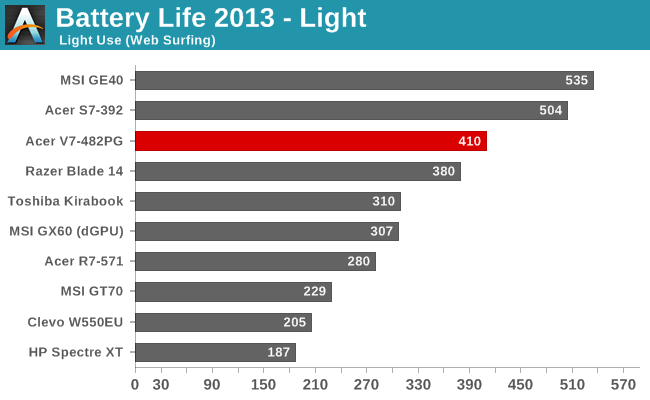
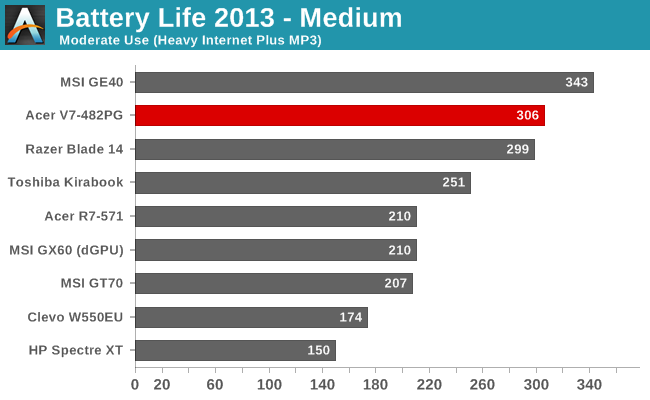
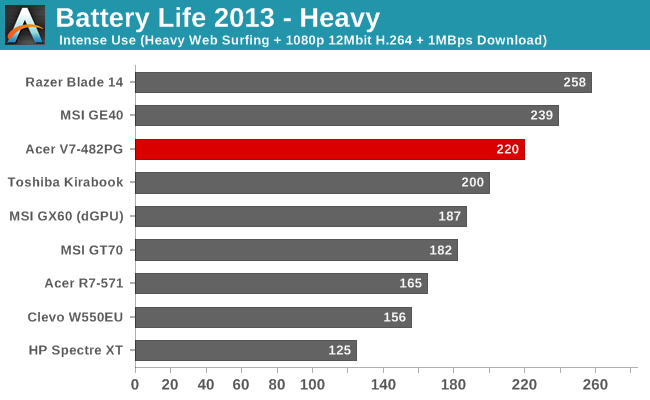
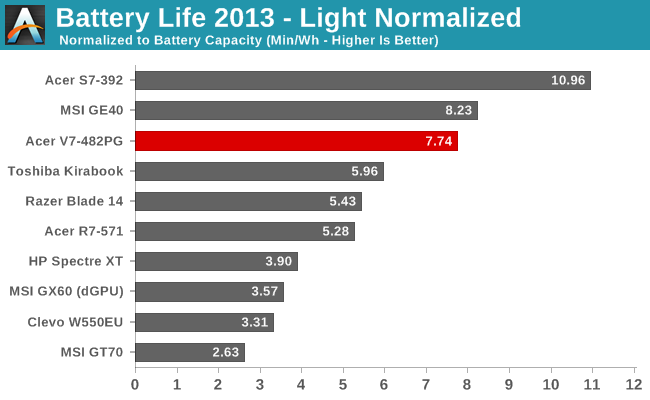
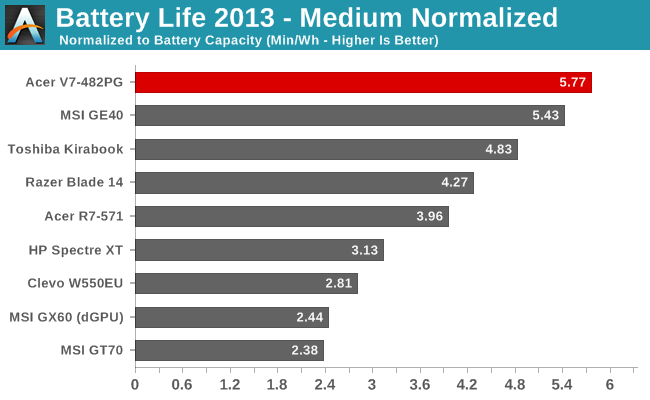
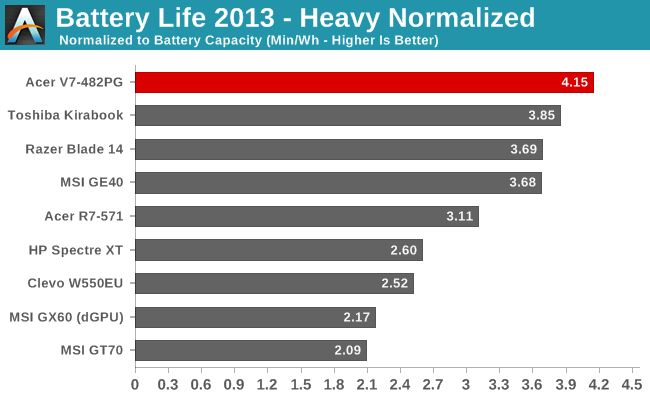
The 53.6 Wh battery isn’t the highest capacity battery you’ll find on market, but it’s the same capacity that Apple uses in the MacBook Air 13 (2013). What’s not the same is the battery life that you get with Windows compared to OS X. With Haswell, the Aspire V7 basically matches what Apple was able to do with the MacBook Air 13 (2012): around seven hours of battery life in our light workload. For reference, the new MBA13 delivered 11 hours in the same test. Still, the Haswell laptops are all posting significant gains over the previous generation Ivy Bridge laptops.
And thanks to NVIDIA’s Optimus Technology, even laptops with discrete GPUs like the MSI GE40 and Acer V7 don’t take a hit to battery life – at least when the GPU isn’t active. Power up the GPU and run a game, on the other hand, and the story changes quite a bit: we measured just 98 minutes of battery life looping 3DMark11 on the Acer V7 (with the GPU set to “prefer maximum performance” in the control panel and using the Balanced power profile). That might seem terrible, and it’s certainly not great, but higher performance GPUs are almost always throttled on battery power, regardless of what settings you use – the MSI GE40 delivered slightly less battery life in our simulated gaming test, with roughly the same performance as the Acer V7 under the same conditions. So basically, on battery power the GT 750M and GTX 760M aren’t all that different, despite the latter having twice as many shaders and substantially more memory bandwidth.
Getting back to the battery life aspect, the V7 posts good results certainly, but I was hoping for even a bit more from our first complete Haswell Ultrabook review. Perhaps the 14” touchscreen is part of the issue, as it could be sucking down precious milliwatts. Other components are also likely a factor, as the Acer S7-392 is quite close to the MBA13. Ultimately, we’re looking at average power draw for the entire laptop of around 7.7W in our Light test on the V7 compared to roughly 4.8W for the MBA13 in the same test under OS X; the S7 Haswell Ultrabook measured 5.4W, which is pretty close to the same sort of gap we’ve seen in the past. As for the V7, coming up with items to account for almost 3W is difficult.
I’m frequently amazed at how much better battery life is with Apple hardware under OS X. We’ve seen in the past that Apple usually optimizes (in a good way) quite heavily in their OS to achieve good battery life, and when you switch to Windows via Boot Camp you lose a lot of battery life. Anand didn’t test Windows battery life with the new MBA13, but I wonder what it’s like, because the usual 30% drop would put it on equal footing with something like the V7. I suspect with Haswell, the opportunities to further tune the OS and hardware for improved battery life are even greater, though, so we might see a 50% drop in battery life with the MBA13 under Windows.
If you need 10+ hours of battery life in Windows, it looks like you’ve got a couple options right now: get a system that’s not as fast (e.g. the V7 has a discrete GPU and hybrid storage with 12GB RAM while the S7 is iGPU only, pure SSD, and 8GB RAM), or find something with a higher capacity battery or a slice battery. For seven hours of useful work – and potentially eight or more if you turn the LCD brightness down a few more notches and don’t constantly surf the Internet – the V7 should be sufficient for most users.










62 Comments
View All Comments
JarredWalton - Saturday, August 24, 2013 - link
The "silliness" was more in reference to the hidden torx screws under the pads. Let me clarify that in the text.evilspoons - Saturday, August 24, 2013 - link
Yes! Torx screws are better given the same physical size, and the screwdrivers aren't exactly expensive or anything. I'd much rather have to spend an extra five minutes finding a Torx driver than strip out a friggin' Philips.KaarlisK - Saturday, August 24, 2013 - link
In 2011, I bought a laptop that weights 1.7kg and has a 35W TDP CPU, and as a result, the CPU and the integrated graphics could actually both boost at the same time.Now we're being offered 1.9-2.5 kilo laptops with 17W CPUs and rather inconsistent performance, especially in games.
It seems silly, especially since the idle power consumption is the mostly same and the prices, at least for Ivy Bridge, were mostly similar.
mtoma - Saturday, August 24, 2013 - link
I think Jarred (and many other ethusiasts) have huge expectations from the displays. Sure, everybody wants 1080p (or higher) IPS displays, but at what cost? Let's not forget that many people don't have many thousands of dollars per month in order to afford such beautiful displays/products. For example, why should'nt be enough an 720p or IPS panel on a 14 or 15 inch laptop? I remember back in 2007 I had an 15,6 inch Fujitsu laptop with a 1280x800 pixels. It wasn't great at all, but it was getting the work done. Remember, a greater display resolution demands much more from the graphichs, and that leads to bigger power consumption. More doesn't always mean better.Regards,
KaarlisK - Saturday, August 24, 2013 - link
A better display is simply _the_ worthwhile upgrade in the era of "good enough" computing.I have a Sandy i3 laptop and a Core 2 Duo desktop, and since I do not much game (or convert videos/run scientific simulations), I still do not feel a need to upgrade my CPU (I do have fast storage and lots of RAM).
More and more I've been catching myself on the thought that my next upgrade might be a ~24'' monitor with high DPI, if one arrives for a reasonable price. With the laptop it is similar – it does everything it is asked to, so the only incentive to upgrade is either a way better screen (better colors and high DPI), or the same performance and OS support in a tablet/phone sized package.
sheh - Saturday, August 24, 2013 - link
Nevermind the resolution, a poor TN is a horrible thing. I'd want laptop makers to use *decent* TNs as minimum, though really I'd prefer something better than TN (with decent response pixel times).I recently got an Asus 15.6" laptop (500-600$ in the US). The TN screen is horrendous. The specs say it's something like 15+30 degrees vertically, but that's a lie. It's more like 0 degrees. There's no single angle where you can see the whole screen undistorted. Maybe if you watch it from 2-3 meter away. Horizontal angles aren't good either, but are less of a problem. I wonder why they don't rotate the panel 90 degrees, as vertical is more important in laptops. The 6-bit dithering is not difficult to notice. The pixel response time isn't too good. And looking at technical specs, it seems there are even worse TN screens being made!
Now, you can get such panels on eBay for about $50. That's for a very poor 6-bit 1366x768 TN. For $150 you can get a 15.6" 1920x1080 S-IPS 10-bit. $100 difference in end user price going from super poor to very good:
http://www.ebay.com/itm/New-15-6-Laptop-LCD-Screen...
You can probably find decent 6-bit 1366x768 IPSes for less than $100.
sheh - Saturday, August 24, 2013 - link
BTW, I didn't say anything about contrast because I don't know what it is. The contrast is variable across the screen (mostly vertically), as are the colors (is this pink or orange? is it dark purple or light? is there a vertical gradient here or is it a solid color?).Pfffman - Saturday, August 24, 2013 - link
I don't think Jarred expects people to buy laptops monthly let alone every year so investing in a nicer screen is still reasonable.When the asking price for the laptop is $1300, 1080 would seem to be expected. Touch is a nice extra. Generally Anandtech will scale their screen expectations according to price. They do have a high emphasis on screen though. They generally only okay TN panels if they are the really good ones or the laptop is clearly budget targeted.
In this time, it might be hard to get a 1280x720 or 1280x800 IPS screen at 14 inch. The panel manufacturers might not bother with it any more.
piroroadkill - Sunday, August 25, 2013 - link
While your old laptop may have had a crap display - many others had old laptops which did not. I have a laptop from 2004~ that has a 15" 1920x1200 screen, a Dell Precision which also has a 15" 1920x1200 screen, an old Dell with a 1400x1050 14".. etc.My favourite laptop and the one I'm on right now is a Sony Vaio Z12, 13.3" 1600x900, and so light. But I added the previous examples to show that some people have ALREADY had higher res screens, and are bewildered that options lack today.
I think the screen on this particular Acer is probably just fine - once calibrated, so they probably should do that from the factory - but I honestly would love to drop the touchscreen entirely, and have a matte finish. But that's me. It would even save some money.
dareo - Saturday, August 24, 2013 - link
"The V7-582PG-6421 has a 15.6” 1080p IPS display, but the CPU is a Core i5-4200U and the GPU is a rather questionable GT 720M"I've been considering this model mainly because of the larger display, which only adds 0.5 lbs to the weight, and my eyes aren’t what they used to be so the extra screen real estate is needed. It would be great if it were as light as some previous generations of the Samsung Series 9, but you can’t have everything.
Taking into account the following use cases, will the lower CPU & GPU specs on the 6421 really make a difference to me?:
At home office (connected to an external 24” monitor):
- Word, Excel, Powerpoint
- email
- web browsing
- occasional hobbyist use of 3D Home Architect
On the road:
- Word, Excel, Powerpoint
- email
- web browsing
- watching videos on flights
While display size at home is irrelevant since I have the external monitor, I find that my current laptop with a 13.3” display doesn’t cut it (for me) on the road when working with the MS-Office suite. Since the laptop is nearly 4 years old and starting to give me some problems, the timing of the new Haswell-based laptops is spot on and I’m looking to get one by the end of the year. Right now there just doesn’t seem to be too many options for a new generation (processor & touchscreen) 15” minimal-compromise ultrabook at a decent price. Calling the V7-582PG-6421 an ultrabook might be a stretch, but it weights the same as my current smaller-screen laptop so it’s acceptable.
Should I be waiting for something else that’s just on the horizon? Are there other alternatives to the V7-582PG-6421 that I should be considering?